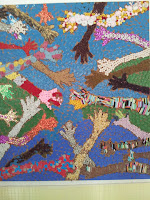There are two things that
stand out in these chapters:
My knowledge of mathematics and how students
learn mathematics – these are essential tools I need to acquire to be an
effective teacher of mathematics. As the teacher, I play an important role in shaping
mathematics for my students. My beliefs
about what it means to know and do mathematics and about how students make
sense of mathematics will affect my instructional approach.
First
and foremost, having a deeper understanding of what mathematic content should be
taught at each grade level., my role in fostering math learning is to integrate
experiences with math into children’s everyday play. To make it work, my
excitement and interest in children’s inquiries will encourage them to talk
through their discoveries. My acceptance of their math reasoning, even when it
may seem ‘wrong or illogical, will give them the confidence to keep thinking,
questioning, and sharing. Most often,
the feelings stem from my childhood experiences with math that placed too much
emphasis on getting correct answers, when the process of finding the answers
was not fully understood. So how can I fight the feelings of math anxiety when
working with children?
 I must remember that I
should never ‘teach’ children math. Children learn math by ‘doing’ Math. Children
need time to explore and discover math concepts on their own in non-judgmental
environment. What children need is an adult to foster interest in them,
encourage them to test their ideas and to keep sharing their reasoning with
confidence and assurance that it will be accepted, no matter what!
I must remember that I
should never ‘teach’ children math. Children learn math by ‘doing’ Math. Children
need time to explore and discover math concepts on their own in non-judgmental
environment. What children need is an adult to foster interest in them,
encourage them to test their ideas and to keep sharing their reasoning with
confidence and assurance that it will be accepted, no matter what!Secondly, I need to know how my students learn mathematics – the awareness of individual development in context; what my students know, are there any common misconceptions and need to learn, then to be able to challenge and support them to learn it well.
The
daily classroom experience that teacher provides has great influence on how and
what students learn about mathematics. It provides a repertoire of activities,
selection of meaningful instructional tasks and the ability to promote
curiosity, questions, develop students reasoning and sense-making skills.
Children needs more concrete experiences. They discover relationships among
objects. Each new discovery about the physical world, and the thinking that
accompanies these discoveries, lays the foundation for later mathematical
learning.
“Learning mathematics is maximized when
teachers focus on mathematical thinking and reasoning”
(NCTM, 2009, n.d.)
No comments:
Post a Comment